
Cyprinidae is a family of freshwater fish commonly called the carp or minnow family, including the carps, the true minnows, and their relatives the barbs and barbels, among others. Cyprinidae is the largest and most diverse fish family, and the largest vertebrate animal family overall, with about 3,000 species; only 1,270 of these remain extant, divided into about 200 valid genera. Cyprinids range from about 12 mm (0.5 in) in size to the 3 m (9.8 ft) giant barb. By genus and species count, the family makes up more than two-thirds of the ostariophysian order Cypriniformes. The family name is derived from the Greek word kyprînos.

The ide, or orfe, is a freshwater fish of the family Cyprinidae found in larger rivers, ponds, and lakes across Northern Europe and Asia. It has been introduced outside its native range into Europe, North America, and New Zealand. It is a popular ornamental fish, usually kept in outdoor ponds in temperate regions from which it often escapes.

Rutilus is a genus of fish in the family Cyprinidae found in Eurasia. This genus is a widely distributed lineage of cyprinids and ranges from West Europe to East Siberia.
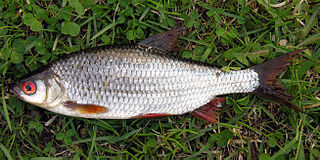
The roach, or rutilus roach, also known as the common roach, is a fresh- and brackish-water fish of the family Cyprinidae, native to most of Europe and western Asia. Fish called roach can be any species of the genera Rutilus, Leucos and Hesperoleucus, depending on locality. The plural of the term is also roach.
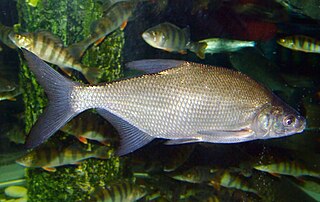
The common bream, also known as the freshwater bream, bream, bronze bream, carp bream or sweaty bream, is a European species of freshwater fish in the family Cyprinidae. It is now considered to be the only species in the genus Abramis.
Luciobarbus graecus is a ray-finned fish species in the family Cyprinidae. It is here placed in Luciobarbus following the IUCN, but that genus is very closely related to the other typical barbels and perhaps better considered a mere subgenus of Barbus. Found in and adjacent to Greece, its closest living relative seems to be L. lydianus, which is found in the northwest of Asia Minor.
The yellow rasbora is a species of ray-finned fish in the genus Rasbora from Southeast Asia. It is a primarily freshwater fish originally from Java island in Indonesia. It is known as the Wader pari fish in the Indonesian language. In addition, it was a protein source for the local community during the old days.

The pugnose shiner is a species of ray-finned fish in the genus Notropis. It is in the family Cyprinidae which consists of freshwater carps and minnows. Cyprinidae is the largest fish family which consists of about 369 genera and 3,018 species. Its distribution has been decreasing due to the removal of aquatic plants in order to create swimming beaches and boating access in freshwater lakes and is now mostly found in Minnesota, Wisconsin, and Michigan.
The Ohrid spirlin is a fish species of family Cyprinidae. This species is endemic to Lake Ohrid in North Macedonia and Albania in the Balkans. It is a benthopelagic temperate freshwater fish, up to 9 cm in length. It was originally named as a subspecies of Alburnoides bipunctatus. It is threatened by non-indigenous species of fish, many of which have been introduced into Lake Ohrid.
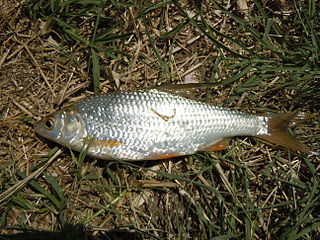
Rutilus heckelii is a species of roach, a genus in the family Cyprinidae. This species occurs in freshened areas of Black and Azov Seas, entering the Don, Kuban, Dniepr, Dniestr and rarely Danube drainages.
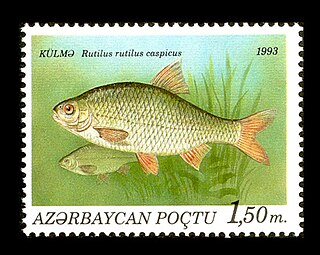
The Caspian roach is a species of roach fish living in the Caspian Sea. The Caspian roach can be distinguished from other roaches by its laterally compressed body, silvery grey iris, rounded snout and grey pectoral pelvic and anal fins with dark margins. The Caspian roach is semi-anadromous and inhabits mostly shallow coastal waters. It enters Volga, Ural, Emba, Terek and Kura drainages for spawning.
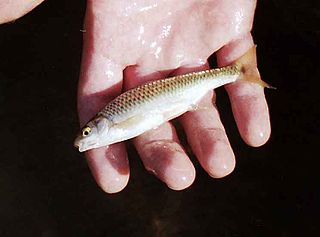
Sarmarutilus rubilio, known as the rovella or the South European roach, is a species of freshwater fish in the family Cyprinidae. It is native in the Tuscano-Latium district of Italy, both in waters draining to the Adriatic and Tyrrhenian Seas, and introduced further south in the country. Its natural habitats are rivers and freshwater lakes. It is threatened by introduced species and habitat loss.

Leucos aula is a species of freshwater fish in the family Cyprinidae. It is native to the Adriatic basin in southern Europe, originally occurring in Italy, Slovenia, Croatia, and Switzerland. It has been introduced to other parts of Italy. This is an abundant fish, occurring in canals, swamps, lakes, and streams with slow current and dense vegetation.
Leucos ylikiensis is a species of freshwater fish in the family Cyprinidae. It is found only in Greece, in the Kifissos drainage and Lake Yliki. The other known population, in Lake Paralimni, was extirpated when the lake was drained. L. ylikiensis was described as a distinct species in 1991. It is threatened by habitat loss.

The pale chub, also known as pale bleak or fresh-water sprat, is one of the most extensively distributed Asiatic cyprinids and is found in Korea, Japan, Taiwan, and most of Southeast China. This species of fish is native to freshwater rivers and mountainous streams from northern China and Korea to northern Vietnam. They can grow up to 20 centimetres (7.9 in) but usually grow to 13 centimetres (5.1 in). Its diet consists of zooplankton, invertebrates, fish, and debris. Zacco platypus is called Oikawaオイカワ in Japan.
Squalius malacitanus, commonly known as the Málaga chub, is a species of freshwater fish in the carp family Cyprinidae. It was first isolated from the Guadalmina River in Málaga, hence its name. It is considered a vulnerable species. S. malacitanus differs from its cogenerate species by having 7–8 branched rays in its dorsal fin, 8 branched rays in the anal lateral line; the number of scale rows above its lateral line; possessing 3 scale rows below its lateral line; 38 vertebrae, 21 abdominal, and 17 caudal; large fourth and fifth infraorbital bones; maxilla without a pointed anterior process; the middle of its frontal bone being narrow, as well as its neurocranium bone; the lower branch of its pharyngeal bone is rather long; and the shortness of the inferior lamina of its urohyal bone.
Puntius madhusoodani is a species of fish in the family Cyprinidae in Puntius genus. The species has been discovered in 2010, named and described jointly by Krishnakumar, Benno Pereira & Radhakrishnan and a study first published in Biosystematica in 2012. It was collected from Manimala River in Kerala, India, which has a running length of only 92 km and empties into the Vembanad Lake. Puntius madhusoodani is named after Prof. Dr. B. Madhusoodana Kurup, as an honour for his contribution towards the taxonomy and conservation of freshwater fishes of Kerala.

The humpback mahseer is a species of freshwater ray-finned fish from the Indian endemic genus Hypselobarbus in the carp and minnow family Cyprinidae.
Labeo heladiva, is a species of freshwater fish in the family Cyprinidae. It is endemic to Sri Lanka. Earlier considered as the same species as Labeo dussumieri in India, recent phylogenetic and physiological differences suggest that Sri Lankan population is a distinct species.

Nuptial tubercles are dermal structures present in 15 families of fish belonging to 4 orders of Actinopterygii – Salmoniformes, Gonorhynchiformes, Cypriniformes and Perciformes – used in the courtship and reproduction process. They consist of partially or fully keratinised cells that form a perceptible protrusion in certain regions, used to stimulate females during courtship. Their development is stimulated by hormones secreted by the pituitary and adrenal glands, and is induced shortly before the breeding season and discarded after. In some species, at least, there is a correlation between the level of androgens present in the endocrine system and the volume and complexity of tubercle growth.












